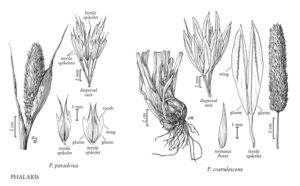Phalaris coerulescens
Plants perennial; cespitose, not rhizomatous. Culms 70-200 cm, swollen at the base. Ligules 4-6 mm, rounded to narrowly acute; blades 4-20(25) cm long, 1-5(7) mm wide. Panicles 3-12 cm long, 1-2.3 cm wide, ovoid to cylindrical; branches with groups of 4-7 staminate (rarely sterile) spikelets clustered around a terminal pistillate or bisexual spikelet; pedicels glabrous or sparsely hispid; disarticulation below individual bisexual spikelets or below the spikelet clusters. Spikelets heterogamous, some staminate or sterile, others bisexual or pistillate, with 1-3 florets, if more than 1, lower floret(s) sterile and highly reduced, terminal (or only) floret staminate, pistillate, or bisexual. Glumes usually 5-9 mm long, to 3 mm long on spikelets near the base of the panicle, 1.1-2 mm wide, glabrous or hirsute, keels winged, wings 0.2-0.5 mm wide, entire or irregularly dentate to crenate distally, lateral veins conspicuous, scabrous, apices mucronate, mucros 0.3-0.7(1) mm; sterile florets, if present, to 1/10 as long the sexual florets, glabrous or almost so; sexual florets staminate, pistillate or bisexual, 2.5-4.5 mm long, 0.7-1.4 mm wide, glabrous or with a few short hairs at the base; anthers 2.5-3 mm. Caryopses 2.8-3.3 mm long, 1.2-1.4 mm wide. 2n = 14, 42.
Discussion
Phalaris coerulescens is native around the Mediterranean; it is now established in northern Europe and South America. It was found in Contra Costa County, California, in 2000.
Selected References
None.
